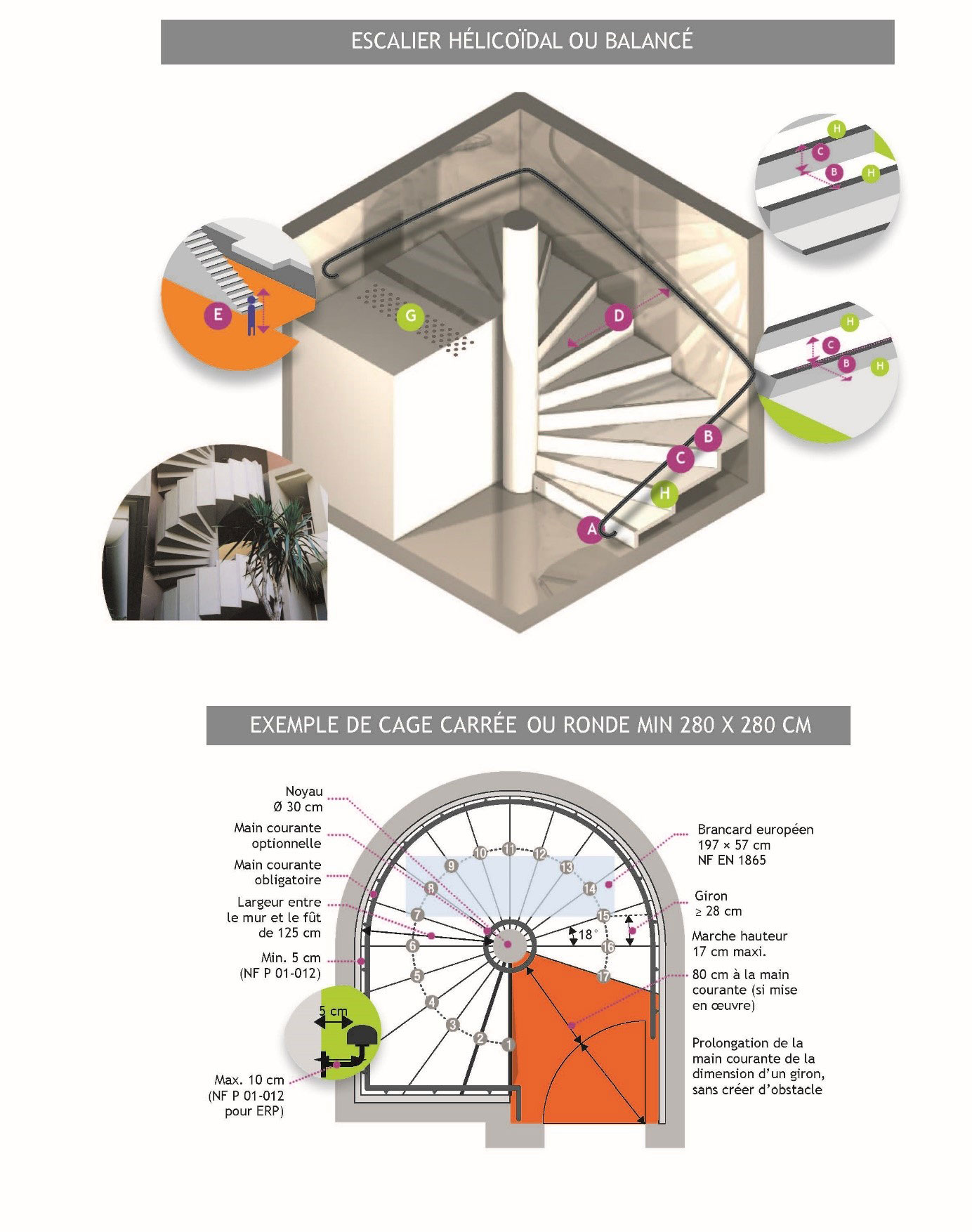![]()
Precast staircases are an increasingly popular choice in the construction sector. These easy-to-install solutions generate considerable time savings while providing a perfect finish and aesthetic appeal.
What is a spiral staircase?
A spiral staircase is a winding or spiral staircase that wraps around a central axis. These stairs may be found in an indoor or outdoor setting. Installing a PBM spiral staircase allows you to safely move your project forward faster, while ensuring a perfect finish.
Why choose an NF mark PBM staircase?
All our stairs have CE and NF marking.
Why have both NF and CE marking and what is the added value?
Some staircases have both CE and NF marking as extra evidence of their quality.
Where harmonised features are involved (requirements given in Annex ZA of standard NF EN 14843), CE marking requires a manufacturer to declare performance values but does not enforce minimum values.
This means that not all CE-marked products necessarily have the level of performance required to conduct building work in accordance with good professional practice such as defined in the French DTU code of practice.
The precast concrete stairs NF mark:
- certifies that the stairs meet a performance level conform to NF certification rules
- guarantees that the product performance requirements have been audited by an independent body and that the manufacturer has been found to comply with these requirements in a sustainable and continuous manner
- guarantees the buyer that the stairs are designed for building structures in accordance with good professional practice and, specifically, with the French DTU code of practice.
- The precast concrete stairs NF mark came into force in 2008
PBM offers a diverse range of precast spiral staircases
We offer a wide range of finishes and technical solutions. These are described in our dedicated interactive catalogue on spiral staircases that you can download from our website: click here
Spiral staircase with solid core, segmented, open well, elliptical, winding with central column, or even self-supporting… there are myriad shapes that can be used for your spiral staircase.
Our sales representatives are ready to help you choose your precast staircases, based on your specific project constraints.
OUR SPIRAL STAIRCASES
Rules and regulations governing spiral staircases
Buildings Open to the Public (ERP)
Facilities Open to the Public (IOP)
DIMENSIONS
A Tread line at a distance of 50 cm from the exterior wall according to the decree of 01/08/06 (at a distance of 60 cm from the core, column or open well so as to comply with fire regulations – Decree of 25/06/80 – Art. CO56).
B Tread: T ≥ 28 cm on the tread line
(Exterior tread < 42 cm)
C Step height 13 cm ≤ H ≤ 16 cm
It is strongly advised that all the steps should be the same height. There is a permitted tolerance on the first step provided that its height is no less than 13 cm
Recommended: 60 cm < 2H+T < 64 cm
D Width between handrails ≥ 120 cm (which gives an inter-wall width of 140 cm)
E Clearance height h ≥ 2.00 m and, if possible, 2.20 m
ENCROACHMENT AND USAGE
F All staircases must have a handrail on each side unless the diameter of the central column ≤ 40 cm
(1 single handrail installed on the exterior side):
• Height between 80 cm and 100 cm measured from the step nosing
• Horizontal projection equal to 1 tread length beyond the 1st and last step, without obstructing traffic, excluding the handrail on the side of the central column if it has a tactile contrast indicating a landing
• Continuous (except where other special conditions apply on the exterior side), rigid and easy to grip
• Easily distinguished from the supporting wall using special lighting or visual contrast
SAFETY
G Warning at a distance of 50 cm (except where other special conditions apply) from the last step of each flight using a system of visual and tactile contrasts.
H Step nosings with a contrasting finish to the rest of the stairs:
• Over a horizontal distance of at least 3 cm
• Anti-slip
• Overhang of the riser ≤ 1 cm
Riser at least 10 cm in height – the risers on the 1st and last step must contrast visually with the other steps.
1 or 2-step staircases are prohibited.
Spiral staircases must wind continuously with no landings other than those at each floor.
GROUP HOUSING
(communal areas)
DIMENSIONS
A Tread line at a distance of 50 cm from the exterior wall
B Tread: T ≥ 28 cm on the tread line
C Step height H ≤ 17 cm
Recommended: 60 cm < 2H+T < 64 cm on the tread line
It is strongly advised that all the steps should be the same height. There is a permitted tolerance on the first step
D Width between handrails ≥ 100 cm (which gives an inter-wall width of120 cm with 2 handrails)
E Clearance height h ≥ 2.00 m and, if possible 2.20 m
ENCROACHMENT AND USAGE
F All staircases must have a handrail on each side unless the diameter of the central column ≤ 40 cm (1 single handrail):
• Height between 80 cm and 100 cm
• Horizontal projection equal to 1 tread length beyond the 1st and last step, without obstructing traffic, excluding the handrail on the side of the central column if it has a tactile contrast indicating a landing
• Rigid, easy to grip and continuous (except where other special conditions apply on the exterior side)
• Easily distinguished from the supporting wall using special lighting or visual contrast
SAFETY
G Warning at a distance of 50 cm (except where other special conditions apply) from the last step of each flight using a system of visual and tactile contrasts
H Step nosings with a contrasting finish to the rest of the stairs:
• Over a horizontal distance of at least 3 cm
• Anti-slip
• Overhang of the riser ≤ 1 cm
Riser of at least 10 cm – the risers on the 1st and last step shall contrast visually with the other steps.
Option of building 1 or 2-step staircases.








